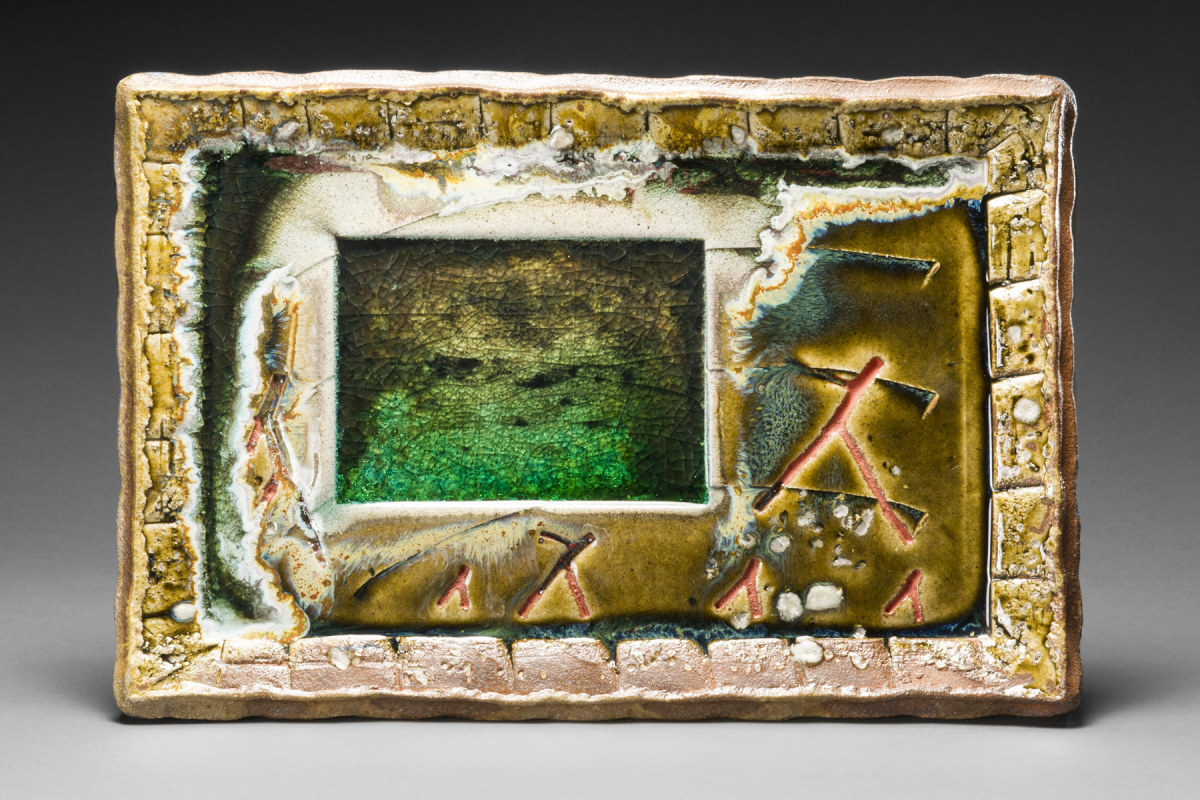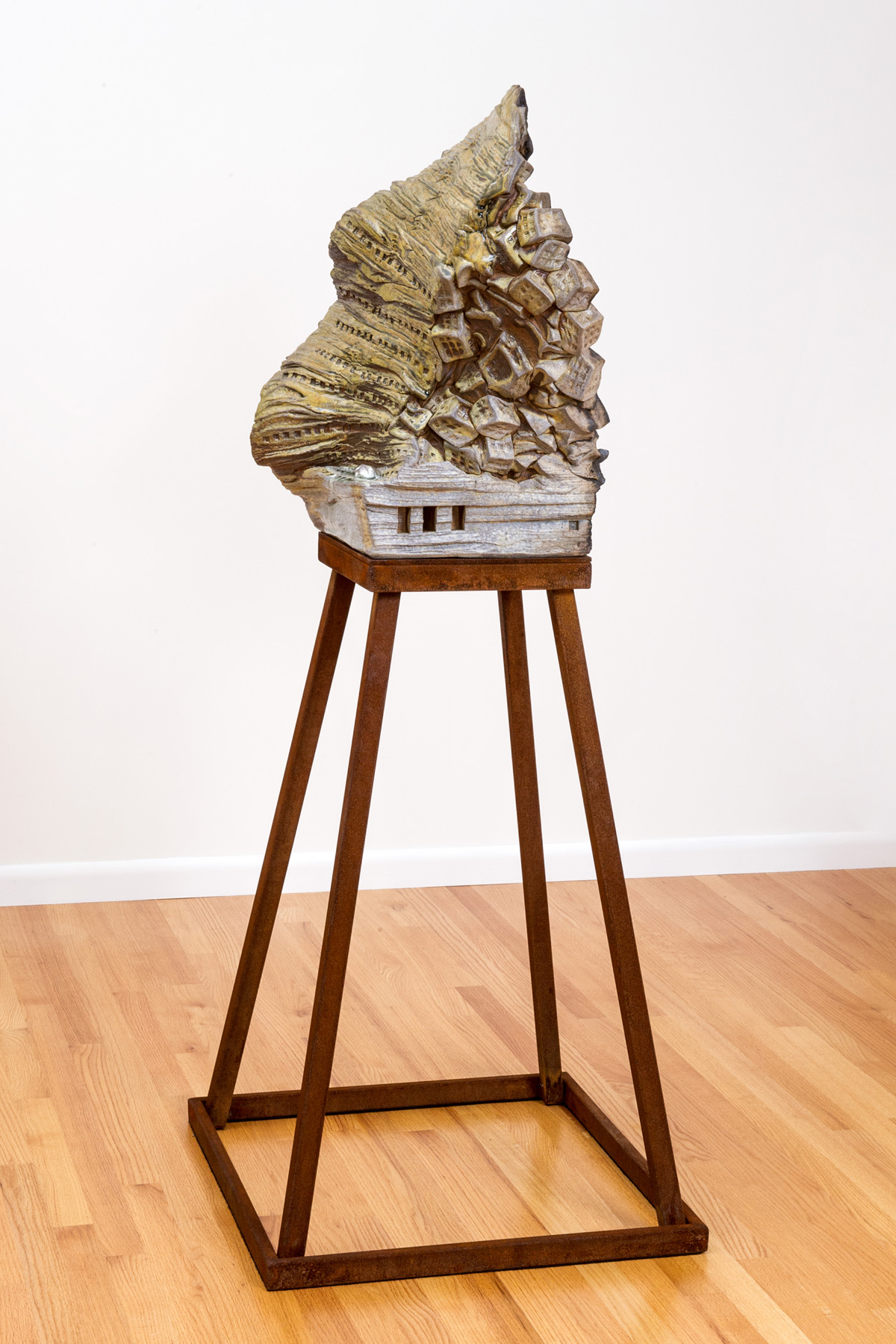
Tony Moore: Transit. Sculpture & Fire Painting
The Painting Center, NYC
January 29 - February 23, 2019
We have admired the kiln magic wrought by such modern-day clay artists as Josep Llorens Artigas (note his own austere vessels along with the outsized, craggy pieces made in collaboration with Joan Mirò). We've loved the brut, wabi-sabi influenced, almost-pots of Peter Voulkos, and the monumental, brightly glazed standing figures of Viola Frey. Now comes along Tony Moore who joins this rarefied company with an exhibition of splendid, anagama-noborigama fired ceramic works at The Painting Center, New York.
With two bodies of work on view, Moore offers the same breadth of imagination and expansive vision that have characterized his art practice over the years. Decades ago Moore, Yale-trained as a sculptor, shifted away from a period of self-assigned apprenticeship in the process of making vessels of clay. While his large vases and pots were themselves unique, he returned to his true path of using clay as an expressive fine art medium. In this current show, we are the benefactors of Moore having married virtuosic craft with an artist’s probing sensibility.
Upon entering The Painting Center Gallery, two commanding sculptures mounted upon stands of rusted steel, greet the viewer. Massive, hermetic, bearers of undeniable visual authority, each possesses an impenetrable density and weight. Shakespeare best asks the question that arises: what is your substance, whereof are you made? (Sonnet 53)
One of the pair, entitled The Injustice of Silence, is a cascading, gyrating tower of dazzling surface complexity. Moving around its girth, each view reveals a radically altered facet of its overall anatomy, like the proverbial elephant’s, requiring the viewer to remember, in order to construct an image of the whole.

Surface colorations transition from rich yellow-browns and umbers, to charcoal grays and blacks. We wonder: Has some unseen force been brought to bear upon this mass? Are we being shown a thing in the process of decay, beautiful in its undoing, redolent of things of the earth, of mud, of blackened soil? Regarding the ganged and sliding cubic shapes so alien to this otherwise biomorphic body, our thoughts turn to man-made things, to architecture or to children’s toy blocks. There is something apocalyptic and chaotic -- a colliding of the natural and the constructed.
The second work, Voice, began its kiln journey as one solid mass. It developed a central crack in drying -- a kiln glitch gone right, a beneficial accident. Its surfaces, gorgeously raked and striated as if Nature were the sculptor, evoke a sense of geological process. Imagine rock formed over eons by earthquakes, by water and extremes of temperature. Peering into the crevasse of this two-fold piece, into the tear itself, we strain to see its full contour, catching but a glimpse of two interior chambers, one on each side. We wonder what they might hold. A sleeping bear? An entombed Pharaoh? The bifurcated womb of Mother Earth, herself?
The second body of work, Moore's Fire Paintings, sing out from the gallery walls. These gleaming chunky rectangular clay slabs are hybrid forms. They have the weight, bulk and dimensionality of sculpture while functioning like painting, as frontally viewed wall-hung works. In their making, Moore added glass and impressed plant matter into the clay, along with a series of luminous glazes. Kiln fire and time transform these "burnt offerings," melting, fusing and pooling pigments and melted glass to create beautiful surfaces and imagery that is both abstract and figurative, often at once. Gaining knowledge of materials and their performance "under fire," Moore's studio experiments evolved to become less random and more directed over time.
Many of these Fire Paintings have a grid motif, a web work of geometrically ordered squares tinted a seductive, jewel-like Mediterranean blue. Moore explains he was inspired to find a way technically to work out the effect of multiple shining windows after seeing sun glinting off the glass of New York City skyscrapers. This viewer can testify that his search was successful.
In the passage quoted below, Moore shares, quite rhapsodically, his reaction to the results of the collaboration between himself and the unseen "fire painter," the god in the kiln:
"The figures, made from cut and impressed twigs, perfectly dovetailed into my pre-existent vocabulary. As I investigated, the figures kept running, fleeing, tumbling, searching, moving away from and towards something else. They moved across landscapes, towards glowing buildings/edifices, systemized structures/societies, which both beckoned them and somehow dominated them. The figures were present, yet also in spirit form, floating and dissolving in diaphanous light and shimmering waters. Twigs became, fathers, mothers and children. They became surrogates, rather like a small child’s dolls, playing out a deeply psychological fiction of desperately moving toward 'something'. Something hopeful, yet presently out of reach. Something eternally becoming..." Tony Moore 2019
Moore's art invokes a confrontation with the raw, natural elements themselves. Daringly executed, inventive and unabashedly beautiful, we are taken into ancillary realms. Art and archaeology align, the fossils of paleontology put in an appearance and twigs become running figures surrounded in light.
We may also take a lesson from Moore in these fraught times. In Tony Moore we find all the qualities expected of extraordinary artists -- talent, technical ability, brilliant innovative ideas and communicative power. We find in Moore as well, and in his art, an affirmation of fundamental values -- exigency, dedication, integrity, and something perhaps ineffable, the transcendent ability to infuse “soul” into matter, to summon pure beauty in the service of profound truth.
